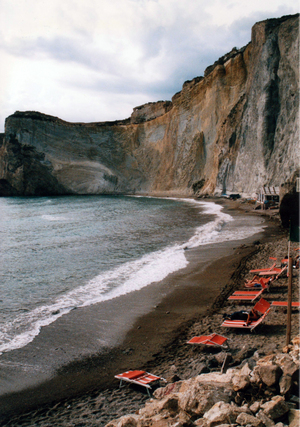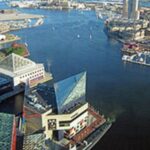Two young lovers meet high up on a secluded cliff above their hometown. Both are engaged to other people and they’re here for an illicit tryst. In any other place, their secret would be closely guarded, but two factors lay against the doomed couple: For one, the Pontine Islands from which they hail, is a chain situated in the Mediterranean, more specifically, the Tyrrhenian Sea, northwest of the mainland port city of Naples. The Pontines are made up of Gavi, Palmarola, Zannone, Ventotene and Ponza. Ponza is the largest of the islands measuring only 5 miles in length and varying between 650 feet and one mile wide. Consider its dimensions: news travels fairly quickly. The affair doesn’t make the town news – at least for a little while – until the next damning event: the spot on which they decide to act out their passions is on a promontory 75 feet high and at the bottom is a swirling pool of agitated turquoise water. They don’t bother to check terra firma and a small part of the cliff gives way, supposedly aggravated by the young man’s – ahem – passionate thrustings. The young woman dies before she plunges to the roiling water, her head smashed on the craggy outcrops of limestone and trachyte above the waterline. The young man’s fate is far worse: he barely survives the fall and becomes quadriplegic.
Ah, the perils of island life. Depending on who you hear it from, this tale is either told with scandalous amusement or grave religious implication. A few years ago, I visited my father who retired back to his hometown after an unsuccessful attempt at American life. For my father, Ponza is his home. The simple, fishing village life of this town is drenched in his DNA, and he made sure at the very least, that he passed onto me the pride of its unique history. Ponza has been inhabited from the Neolithic period through the Ancient Roman era and because of its isolated geography, the islands mainly served as penal colonies for whichever regime in power at the time. Many Roman and Etruscan influences still exist. But my favorite piece of history about Ponza is that it actually holds a place in Homeric mythology as Circe’s lair. Who else can claim that kind of history about their hometown? Take that, Buffalo.
By the Middle Ages Ponza had been abandoned when the Saracens, Bourbons and pirates constantly raided it. By the middle of the 19th Century, the kingdom of Naples repopulated it and today, though still a better kept secret than its southeast neighbors Ischia and Capri, Ponza is rapidly becoming a major tourist attraction. The island’s population varies according to the season. Only the hardcore locals stick around for the wet, cold and windy conditions that the late autumn and winter months bring. It’s desolate, wet and gray, and unless you’re looking to discover a genetic predisposition for Seasonal Affective Disorder, it’s best to stay away. The ensuing summer months more than make up for this dreary period as the weather markedly changes to shocking blue skies, a warm lemon sun, and gentle trade winds that lick and cool the sweated brow.
A boat ride around the entire island is not unreasonable and it can be done in a day. There are some beautifully rocky, prehistoric-looking coves, exquisite beaches like Frontone, Cala Feola, and the weirdly beautiful Chiaia di Luna, a massive crescent shaped beach that makes one feel oddly claustrophobic. Normally, beaches should be expansive stretches of golden sand, but this one is backed by a looming 70 foot wall of rock that looks as if it’s going to double over on you any minute. Not to say Chiaia di Luna isn’t beautiful. In fact, it’s a raw display of nature in all its complete splendor and menace. Since it’s buttressed by such a thick wall, there are only two ways to get to it. Either you approach the beach via boat or you reach it from behind by way of a man-made tunnel. Built in Roman times, the tunnel is dimly lit, although the recent introduction of electricity and orange lights help some. For about a quarter kilometer, the tunnel snakes its way through the middle of the mountain, and finally spits you out midway atop the beach. Think literally the light at the end of the tunnel. It’s just a really strange way to get to a beach, but it’s certainly a great payoff when you finally come through and see it.
Beaches are plentiful along Ponza’s forty kilometers of coastline, but they’re still the exception than the rule. Instead, steep cliffs of igneous rock shoot up from the water without the inviting transition of a shoreline. Of course this doesn’t deter sun worshippers one bit. On the remoter parts of the island, it’s not unusual to come across nude sunbathers reclining on a flattened piece of bleach white embankment nestled in a sleepy cove somewhere. The blinding white walls of Cala Inferno, and other contorted outcroppings are eerily disorienting and if you were to observe them free of any surrounding context, you could feel easily displaced — as if you suddenly found yourself on a particularly docile part of Mars. But then, you’ll likely come across some fat naked person sizzling in the sun, friendly waving, and all is well again.
Independent rock formations or scogli as they’re called, sprout from the sea in varying shapes and sizes. They’re place markers throughout the island, or nature’s statues as I like to call them. Sea caves similar to the Blue Grotto in Capri also exist here. They are beautiful geological creations that one should never pass up the chance to experience. I can’t adequately explain the phenomenon, but water inside the cave absorbs all colors of the spectrum except for blue and/or green, which is reflected in a radioactive glow of aquamarine or emerald. The stones just below the water resemble paraiba tourmalines, and it’s as if you’ve stepped inside a shimmering jewel. It’s really an otherworldly experience.
Scuba diving and snorkeling are always available, and if you’re feeling particularly adventurous, you can go to Palmarola, Ponza’s neighboring island. Palmarola is part of the Circeo National Park, a wildlife preserve meant to keep the island free from any commercial development. Pristine and wild, Palmarola makes for an amazing day trip. It’s about a forty five minute boat ride, so pack a lunch and just go exploring various caves or pick a spot and scuba dive or swim the translucent blue waters. Unless you’re an archaeologist or botanist, there’s really nothing more to see or do there, but the beauty of these waters in and of itself is a reward to enjoy.
The other islands, Gavi and Zannone, are just heaps of rock. Skip it. Ponza is where you will do all of your shopping, beach hopping and restaurant/nightlife pursuits. Summer is the only time the locals can make their living, so commercialism is ramped up. There are many tour stations from which you can rent a boat, reserve a leisurely sail around the island, or book a scuba diving stint. There’s a host of seafood restaurants (naturally) and jewelry stores that offer everything from souvenirs and trinkets to fine coral harvested directly from the island. Clothing stores that sell mostly t-shirts and beach wear, as well as snorkeling gear also abound. Boutiques and ceramic shops are also beginning to make an appearance, but on the whole don’t expect anything too high end. Ice cream shops, or gelatterie, are an Italian summertime mainstay, and Ponza is no exception. You can find most of these establishments along the promenade that outlines the main port of Sant’Antonio.
The summer nightlife is rather staid compared with what you may find in the big city. You’re more likely to spend the night having dinner at a restaurant with friends and a leisurely nightcap afterwards. Every June 20, the island observes the day of its patron saint, San Silverio. It’s Ponza’s major annual festivity and everyone parties well into the morning hours with live music concerts, street dancing and fireworks. The celebration kicks off during the day with an ungodly interminable mass at the main church, followed by a street parade with the icon of the 15th century saint in tow. The procession is a curious sight, especially when the statue completes its march back to the church and becomes a tawdry spectacle of money stuck everywhere on its person. The island really comes alive for this event, so avail yourself of the festivities should you be here around this time.
Also, don’t limit yourself to the commercial town center of Sant’ Antonio. There are other neighborhoods throughout that are less crowded and offer a better sense of the unadorned life this island provides. If you’re not scared of roads without a guard rail or shoulder, then take a speeding bus up a spiraling mountain to Le Forna, a section of town on the most elevated part of the island. It’s great for hiking and the vistas are particularly striking. Take note of the wild cacti running rampant up mountainsides or the sea of yellow ginestra that blooms over the undulating topography. Also be sure to try one of the restaurants there, some of which are extensions of people’s homes. The food is always fresh and the atmosphere casual. While I was waiting for my main course, I hopped onto a neighboring roof and snapped some spectacular shots of a sunset over Palmarola.
Since I’ve never had to deal with lodging, I can’t comment on the availability of hotels, their ambience or quality of service. In the past decade alone, hotels, bed and breakfasts, inns, and rentals have all mushroomed throughout the entire island to accommodate the influx of tourists. Real estate is a precious commodity for such a small island, and this is readily apparent if you survey it from the waters of the main port. Multicolored houses are stacked one on top of the other, dotting the hills like a fungus sprouting on tree bark. Local neighborhoods once far removed from the town and tourist center are now being snapped up by wealthy Europeans, but Ponza still maintains its feel of wild prehistory.
However, much to my father’s disappointment, Ponza is far too commercialized and overdeveloped for him. The crowds swell to ever more intolerable heights with each passing summer. With growing media attention and changing economies, Ponza is adapting and evolving from the quaint sleepy fishing isle of my father’s youth to another artificial tourist trap. Determining authenticity is just another relative pursuit, so for my big city sensibilities, Ponza is still a natural jewel. You’ll never see a Fairmont or a Hilton pop up here. I’ll toss my cookies if I see a McDonald’s, and I’ll personally dive head first into pool of said cookies if an Arby’s should sprout alongside the church. So until such time, I’ll gladly take what Ponza has so far become: a summer vacation retreat for rich Romans who snatch up property along its hilly terrain, remake them into luxurious summer homes and paint them bright breezy colors; Scandinavian families who visit for the scuba diving; Neapolitan twenty-somethings that flock in droves to supersaturate the beaches; semi-estranged American sons who come back to reconnect with their roots.
*************************************************************
If you want some visuals of what I described in my travel review, go to my Travelogue
When you Google “Ponza” most of the sites are in Italian. Even if you translate the page, it’s barely understandable. But it’s still worth checking out for maps and topography, boat schedules to get from the mainland to the island (you can’t get there by plane), hotel availability, etc.







